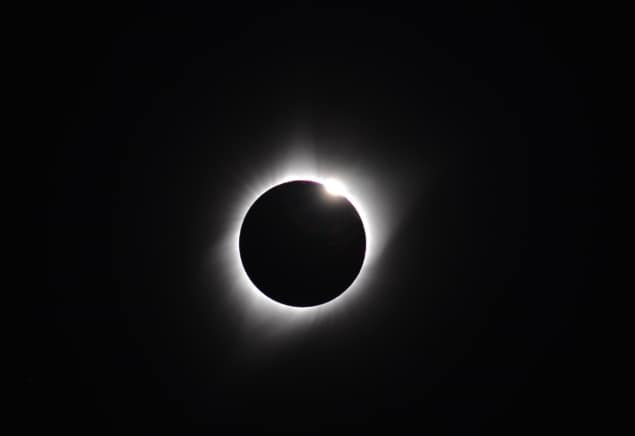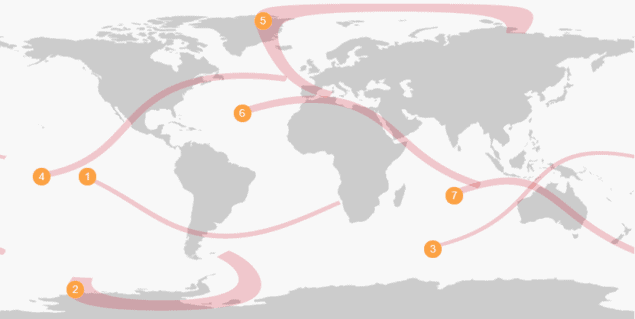
It is one of nature’s most spectacular shows. Next week – for the first time in almost two years – the Earth, Moon and Sun will fall into perfect alignment and produce a total solar eclipse. The Moon’s umbra (the dark part of the Moon’s shadow, where the Sun is completely obscured) will touch down in the South Pacific on 2 July and, in just 2 hours 44 minutes, trace a path of totality that extends more than 11,000 km around the globe.
Yet a total eclipse is also one of nature’s most elusive shows. The path of totality may be thousands of kilometres long, but it is only about 160 km wide. Plus, the umbra seems to enjoy making things complicated. For the first 10,000 km of its journey across the Earth next week, for instance, the only landmass that the umbra encounters will be the remote coral atoll of Oeno (part of the Pitcairn Islands group). And although the umbra completes its journey by crossing Chile and Argentina, the average cloud amount is more than 50% for most of this overland phase.
The point is, catching totality is not a straightforward exercise. You have to make sure you’re in the right place at the right time, and it helps to pay attention to the weather prospects. There are many people who have a total solar eclipse on their list of things to do in life; there are far fewer people who manage to plan ahead, put everything together, and actually get to experience totality.

With this in mind, here is a guide to the next seven total solar eclipses, which takes us up to the end of the 2020s. If you’ve ever wondered what it’s like to watch the Sun slowly be eaten away, to feel the change in the air as totality approaches, to hear the gasps of the people around you as they behold the solar corona – “one of the most brilliant and splendid phenomena that can well be imagined” as the astronomer Francis Baily said in 1842 – it’s time to start thinking ahead.
The above map shows the next seven paths of totality, and the notes below highlight some of the places that the umbra visits. The map and the following data on length of totality and average cloud cover are from timeanddate.com/eclipse.
14 December 2020: Chile and Argentina
It hardly seems fair. Next week’s total solar eclipse crosses Chile and Argentina; the one after that, 17 months later, crosses the same two countries again. (Fun fact: Chile and Argentina also shared/share annular eclipses – where the moon is too far away to cover the sun completely – in 2017, 2024 and 2027.)
Where to see it
Ministro Ramos Mexía (Río Negro, Argentina)
Length of totality: 2 min 10 sec | Average cloud cover: 31%
This small village in the Patagonian province of Río Negro lies on the centre line of the path of totality, about 60 km from the point of greatest eclipse.
4 December 2021: Antartica
One of the interesting points about this eclipse, other than its inaccessibility, is the shape of the path of totality on the map. Usually, the umbra sweeps gracefully from left to right, but in the polar regions the distortions of the map can make it appear as if the umbra turns back on itself.
Where to see it
Union Glacier Camp (Union Glacier, Antarctica)
Length of totality: 49 seconds | Average cloud cover: 36%
A privately run camp that provides support to Antarctic expeditions from November to January. Access is via a flight from Punta Arenas in Chile.
20 April 2023: Australia, Timor-Leste and Indonesia
A rare hybrid eclipse. It begins as an annular eclipse over the southern Indian Ocean; turns into a total eclipse; crosses Australia’s North West Cape (a 100 km-long peninsula, 1000 km north of Perth), Timor-Leste (also known as East Timor) and the sparsely populated Indonesian province of West Papua; then turns back into an annular eclipse over the western Pacific.
Where to see it
Exmouth (Western Australia, Australia)
Length of totality: 58 seconds | Average cloud cover: 16%
The largest town on the North West Cape. “Word coming out of Exmouth is that all the hotels are fully booked,” says Matt Woods from the Perth Observatory, “but there’ll be plenty of camping sites.”
8 April 2024: Mexico, USA and Canada
Seven years after the Great American Eclipse swept across the US from Oregon to South Carolina, the Great North American Eclipse runs from the Mexican state of Sinaloa to the Canadian province of Newfoundland and Labrador.
Where to see it
Nazas (Durango, Mexico)
Length of totality: 4 min 29 sec | Average cloud cover: 24%
The small town of Nazas is just 10 km from the point of greatest eclipse.
Dallas (Texas, USA)
Length of totality: 3 min 53 sec | Average cloud cover: 60%
Other US cities on the path of totality include Austin (Texas), Little Rock (Arkansas), Indianapolis (Indiana), Cleveland (Ohio) and Buffalo (New York).
Niagara Falls (Ontario, Canada)
Length of totality: 3 min 32 sec | Average cloud cover: 62%
The umbra will also visit Montréal in Quebec.
12 August 2026: Greenland, Iceland and Spain
An evening total eclipse across Spain, from the coast of Galicia to the island of Mallorca. “Observers should look from elevated sites or places with no tall buildings or mountains towards the west horizon,” says Amelia Ortiz-Gil, an astronomer at the University of Valencia. “The sun will be quite low in the sky.”
Where to see it
Reykjavík (Iceland)
Length of totality: 1 min 03 sec | Average cloud cover: 76%
Before arriving in Spain, the umbra will pass over the (possibly very cloudy) capital of Iceland.
Valladolid (Castilla-León, Spain)
Length of totality: 1 min 29 sec | Average cloud cover: 19%
“The wide flat expanses of Castilla-León will be great observing spots,” says Amelia.
Valencia (Valencia, Spain)
Length of totality: 1 min 00 sec | Average cloud cover: 31%
“It’s a bit early to say, but I’m sure we will organise some public observations of the eclipse in Valencia, and at our observatory in Aras de los Olmos, which is 80 km from the city at an altitude of 1300 m,” adds Amelia.
2 August 2027: Atlantic, Mediterranean, Red Sea and Indian Ocean
The decade’s most multinational total eclipse crosses 12 countries/territories from Morocco to the British Indian Ocean Territory. The duration of totality at the point of greatest eclipse – which reaches 6 min 23 sec near Luxor in Egypt – will be the longest until the year 2114.
Where to see it
Gibraltar (Gibraltar)
Length of totality: 4 min 29 sec | Average cloud cover: 16%
A mid-morning eclipse for the Rock of Gibraltar.
Luxor (Luxor, Egypt)
Length of totality: 6 min 22 sec | Average cloud cover: 0% (zero)
The site of the ancient Egyptian capital Thebes, Luxor is known as the world’s greatest open-air museum.
Mecca (Hejaz, Saudi Arabia)
Length of totality: 5 min 16 sec | Average cloud cover: 4%
Islam’s holiest city, only Muslims are allowed to enter Mecca.
22 July 2028: Australia and New Zealand
This kicks off something of a golden period for Australasian total eclipses: the umbra will cross Australia again in 2030, and both Australia and New Zealand in 2037 and 2038.
Where to see it
Mitchell Plateau (Western Australia, Australia)
Length of totality: 5 min 10 sec | Average cloud cover: 8%
The Mitchell Plateau area on Australia’s north-west coast includes the point of greatest eclipse. “The Mitchell River National Park contains majestic waterfalls, Aboriginal rock art and sites of cultural significance to the Wunambal indigenous people,” says Matt Woods. “It’s recommended that you book your travel and accommodation early as it’s a very remote part of our beautiful state.”
Sydney (New South Wales, Australia)
Length of totality: 3 min 48 sec | Average cloud cover: 47%
“Sydney will give photographers fabulous places to take photos of the eclipse,” reckons Matt.
Dunedin (Otago, New Zealand)
Length of totality: 2 min 51 sec | Average cloud cover: 59%
The path of totality also takes in the Otago region’s main tourist towns: Queenstown and Wanaka.
Good luck with your planning, and always remember: NEVER look directly at the sun without protecting your eyes.



